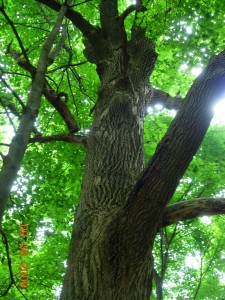Western Michigan University’s student paper, the Western Herald, published an article Monday 14 September 2009 on WMU’s proposed action against the Colony Farm Orchard. The article, by news editor Fritz Klug, was titled Arrested development for BTR? Possible expansion for WMU business research park draws controversy.
The article with two color photos occupied the whole front page. One of the photos was a slightly elevated view of the south part of the Orchard from the west side of US–131. The other was an aerial photo from 2007 of the Orchard and the Asylum Lake Preserve. Both are seen to slightly better advantage in the online version, which also includes a few lines of text not present in the printed version.
The article is a worthy attempt to give the campus community the basics of what has happened and is proposed.
Two letters to the Herald responding to the article were printed on line on 17 September. They are given below with the Herald titles . My letter is slightly expanded here over the 300-word version submitted to the paper.

A large open-grown tulip tree now surrounded by other trees at Colony Farm Orchard. Photo by Richard Brewer
Colony Farm Orchard IS being utilized
Thanks to the Herald for information on the proposed development of the Colony Farm Orchard — currently dedicated open space. Information has been an item in short supply around the campus. Although many statements quoted in favor of the plan seem questionable, I’ll mention just one, by WMU Board Chairman Kenneth Miller, “That property [Colony Farm Orchard] isn’t really being utilized now.”
Exactly the same argument was made about the Asylum Lake property when WMU tried to turn it into a business park in the 1990s, and failed: It isn’t being utilized, the public was told.
Why might the Colony Farm Orchard not be utilized, if it’s not? One reason might be the five‑foot fence and locked gate along Drake Road. Putting up a fence and then charging the land is not “utilized” sounds a lot like the story about the person who murdered his parents and asked the court for mercy because he was an orphan.
But in what sense is the land not utilized? Some people have always found their way around or over the fence to bird watch, pick wild asparagus, or commune with nature. One local documentary film maker has spent many hours there photographing wildlife. The city of Kalamazoo dumps leaves in one area, and fishermen dig through them for worms. Such uses go on.
But the way the land is “really” utilized is ecological. For one thing, the biomass on the land has increased steadily since farming stopped. This means stored carbon, so WMU — perhaps without knowing it — has been fighting carbon dioxide buildup in the earth’s atmosphere. But most important, the Orchard makes the Asylum Lake Preserve functionally a larger sanctuary, adding habitats, species diversity, and stability.
What “not really utilized” means to WMU is that the land isn’t producing any direct income. Income is good. But there are other goods.
–Richard Brewer
Those against orchard destruction not being heard
I am pleased to see a discussion of the Colony Farm Orchard controversy in the Herald, but ask you to treat this issue more even‑handedly. Those opposing destruction of the Orchard as open space for public use are not being heard in ways that fairly represent that position. There are at least three large issues which should be addressed in open public debate:
1. There was an agreement made with those who transferred the property to WMU and with the community, that lands north of Parkview would remain open space for public use and those to the south would be developed by WMU without further hindrance. The public met its side of the agreement, while WMU is finding it inconvenient to honor its side. Like the U.S. Government in the land treaties it made with Native Americans, WMU is never satisfied. Instead of husbanding its resources with rational land‑use planning, it gobbles up gigantic amounts of land for very little use and quickly comes back demanding more. WMU must learn to keep its word.
2. This is not an environment versus development issue. Any growth of the BTR park could easily be accommodated by infilling at the Lee Baker farm or by redeveloping the many expansive brownfields nearby. A publicly funded research university should act in the public interest. It should redevelop abused industrial lands instead of contributing to suburban sprawl and further degradation of what little public parklands remain.
3. The process that WMU and Representative [Robert] Jones have followed seems to be designed to avoid public disclosure and discussion. Legislation was rushed through the commerce committee during August vacation time. Neighborhood groups were misled about WMU’s plans and timing. Fritz Klug’s article quotes [Bob] Miller saying, “the community will be involved with every step of the planning process.” Does this mean that once the restrictions for public use have been stripped away, WMU will start telling people what it’s going to do with what used to be their dedicated open space?
–Ladislav Hanka